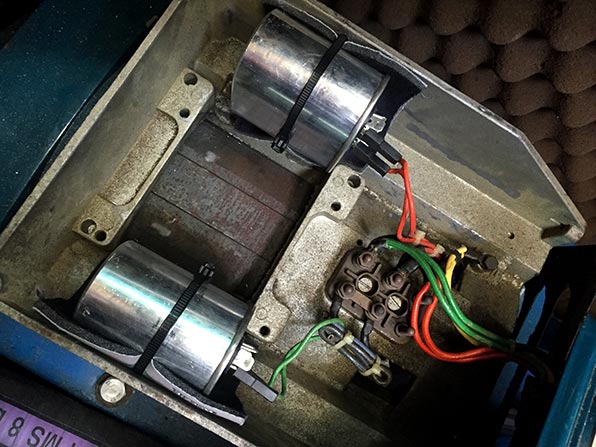Back in business!
When I posted the other day that I intended to check the capacitors on our generator to see if they were the source of our low-voltage issues, I received a bunch of advice from friends and followers. To recap, our issue was that when the generator was first started up, we would have very low output voltage. When a load was placed on the generator, a large load, like our watermaker, the voltage would go up, but still not as high as it should have. It had to be a significant load too as our battery charger wouldn’t do it. In fact, the charger wouldn’t even turn on, the voltage was so low (good thing the wind and solar have been keeping our batteries happy).

Output voltage with no load applied.

Pre-repair output voltage with a load on it.
Some suggested that we check the frequency that the generator was running at because, if the motor was running too slowly, we would have low voltage at the output. Others suggested that the problem could be the brushes. It’s a good thing that I didn’t pursue that tack as, according to our friend, our little generator doesn’t even have brushes!
It just so happened that when I called our electrician friend Simon Clay to ask for his advice on how to check the frequency, he told me that he was just on his way to Prickly Bay, where we were anchored, to do some work on another boat. He offered to stop by when he was done to give the gen set a look.
When he arrived, not long after that phone call, we fired up the gen set and he checked the frequency. Simon did a few other checks too, and after completing them, surmised that it was the capacitors after all. He also commented that the two banks of 5uF capacitors that were wired in the electrical box were not original. He suspected that at some point in the past, when the original capacitors went bad, the previous owner simply replaced the 15uF ones with what was available at that time. Simon offered to run to shore to buy us a couple of replacements, and in less than 30 minutes, he was back on the boat with what we needed: 2 – 15uF capacitors.

The generator was wired with 2 banks of three 5uF capacitors, connected in parallel.
Plenty of connections to shake loose!

A better solution was to use 15uF capacitors.
Total price of the new parts: $16.70 EC, about $6.00 US!

A much cleaner solution!
The big question is, did the new capacitors fix the problem? Yes. In fact, seeing the output now, I don’t think the generator has ever operated at the proper voltage! Additionally, the two cylinder engine vibrates a fair amount so, with the number of electrical connections reduced significantly, we are much better off. I say that because we have had numerous problems with connections to the old capacitors vibrating loose or breaking. Hopefully, now, that will be a thing of the past.

Output voltage after replacing the capacitors, as it should be.
Note: As you can imagine, at that low price, Rebecca and I went back to the store and purchased two more of those capacitors to keep on board as spares.



Glad your gen is back in business. It looks like the capacitor terminals could use a little extra insulation where they are near the metal chassis in the middle, particularly the bottom cap in the much cleaner solution pic.
There is no risk of it touching. The capacitors are fixed in position.
Fixed in position until the cable tie breaks. Have you got many fire extinguishers on board?
Point taken. Compared to how it was wired before, that is a work of art!
And yes.